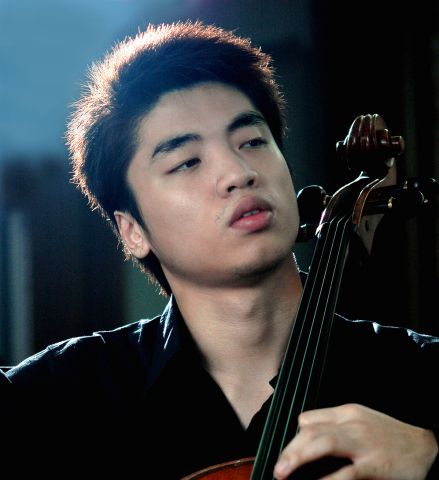Sibelius & Saint-Saëns
In celebration of his 100th birthday, this program opens with a composition of James Niblock, former concertmaster of the Lansing Symphony. The Symphony also celebrates a current Principal player, Cellist Hong Hong, who takes centerstage to share his artistry in Saint-Saëns’ Cello Concerto.
Conductor
Timothy Muffitt
Hong Hong
Cello
Three American Dances
James Niblock
Lansing has its own “Renaissance Man” in the person of its former concertmaster, James Niblock. Celebrating his 100th birthday in 2017, this indefatigable man is still conducting and composing!
He was born in Scappoose, Oregon and did his undergraduate work at Washington State University. He received his M.A. from Colorado College and Ph.D. from the University of Iowa. He studied violin with Franck Eichenlaub, Jascha Brodsky, and Josef Gingold, and his principal composition teachers were Roy Harris and Paul Hindemith. He served in the Air Force during World War II, married Helen Beall in 1947, and began his thirty-seven year tenure at Michigan State University in 1948. He taught theory and composition, performed in the Beaumont String Quartet, and served as Chairman of the College of Music for fifteen years. He has served as Vice President of the Blue Lake Fine Arts Camp Board of Trustees for more than forty years, and he continues as Director of the Opera Program and Composer in Residence at the camp. In April 2006, Michigan State University honored Dr. Niblock with the first ever Distinguished Emeritus Faculty Award.
Dr. Niblock has more than 150 major compositions of which 100 have been published and frequently performed. He wrote his Three American Dances for the Dallas Symphony Orchestra, conducted by Clyde Roller (who was the Music Director of the Lansing Symphony from 1967–1978). Professor Niblock writes, “In reality the title refers to a style or character of expression, since the movements are not dance movements at all but merely express the character or mood of certain traditional American dances.”
Program notes by John VarineauCello Concerto No. 1
Saint-Saëns
Although he was once in the avant-garde of French composers—and considered dangerously subversive—Camille Saint-Saëns lived long enough to be almost forgotten and relegated to the class of “old-fogeys.” By the beginning of the twentieth century, the French composer Reynaldo Hahn could say, “Today, it takes courage to admire Saint-Saëns.” At the same time, abroad in England and America, people considered Saint-Saëns as the greatest living composer.
Camille Saint-Saëns was a true child prodigy. He wrote his first piano music when he was only three. He was ten when he gave his debut piano recital. The program featured solos by Handel, Kalkbrenner, Hummel, and Bach, a concerto by Mozart, and Beethoven’s Third Piano Concerto, all played from memory. For an encore, he offered to play, again from memory, any of Beethoven’s thirty-two piano sonatas! He wrote his first symphony when he was only 13. “I live in music like a fish in water,” he stated. Saint-Saëns wrote music in all of the major genres: operas, ballets, sacred works, songs, symphonies, chamber music, and lots of music for solo piano. He wrote five concertos for the piano, three for the violin and two for cello.
In 1872, Saint-Saëns’s much-revered great-aunt Charlotte died. She was his “first teacher and second mother,” and he was completely unprepared for her death. He turned to composing for comfort and wrote two pieces for cello in quick succession, his Sonata in C minor and his first cello concerto. He wrote the concerto for the virtuoso Auguste Tolbecque. In tribute to both Tolbecque’s fame and the audience’s increasing desire for new music by French composers—a result of Saint-Saëns’ constant promotion—it received its premiere performance at the prestigious Société des Concerts du Conservatoire, a notoriously conservative presenter.
Like many “avante-garde” composers of the Romantic era, Saint-Saëns liked to toy with classical form. In his CelloConcerto in A Minor, he took the traditional three movements (with the tempo scheme of fastslow-fast) and collapsed it into a single-movement work. In addition, he took what is called “sonata form” and spread it out over contrasting sections. Finally, Saint-Saëns dispensed with the long, drawn-out orchestral introductions and interludes and turned the concerto into a true dialogue between soloist and orchestra.
After just one short chordal explosion from the orchestra, the cellist launches the first movement with a series of breakneck descending triplets. After barely thirty seconds, the soloist utters the second, more lyrical theme. Then it is back to the races. An impassioned interlude introduces a development section where orchestra and soloist trade bits and pieces of both themes. The tempo slows down and the cellist transitions to the central section. It is a genteel minuet played by the orchestra while the cello plays a tender countermelody. As it winds down, the oboe restates the triplets from the beginning of the concerto as herald of the final section of the piece. It acts like a recapitulation of the opening, but Saint-Saëns introduces new melodies, both slow and fast. They have such direct ties to the opening that you get the sense of a unified whole.
With this concerto, Saint-Saëns mollified those critics of his modernity: “If Mr. Saint-Saens should decide to continue in this vein… he is certain to recover many votes that he lost with his all-too-obvious divergence from classicism…”
Program notes by John VarineauSymphony No. 3
Sibelius
Jean Sibelius wrote his symphonies at a time when writing “pure” music was unfashionable. Audiences wanted music that told a story—that meant something—and most composers obliged. Richard Strauss wrote tone poems, and Gustav Mahler created entire worlds with his monumental symphonies. Even the French got into the act with the impressionists Claude Debussy and Maurice Ravel. Sibelius also obliged with his tone poems En Saga, the Karelia Suite, Lemminkäinen Suite (based on the Finnish myth Kalevala), Pohjola’s Daughter, The Oceanides, and Tapiola. His most famous tone poem is Finlandia. It quickly became the signature piece for the Finnish nationalist movement soon after he wrote it in1899. However, Sibelius held the line with his symphonies:
“Since Beethoven’s time all so-called symphonies, with the exception of those by Brahms, have been symphonic poems. In some cases the composers have given us a program or have at least suggested what they had in mind; in other cases it is evident that they were concerned with describing or illustrating something, be it a landscape or a series of pictures. That does not correspond to my symphonic ideal. My symphonies are music conceived and worked out solely in terms of music, with no literary basis. I am not a literary musician… for me, music begins where words cease. A scene can be expressed in painting, and drama in words, but a symphony should be music first and last. Of course, it has happened that, quite unbidden, some mental image has established itself in my head in connection with a movement I have been writing, but the germ and fertilization have been solely musical.”
Although Sibelius was insistent that his symphonies started as pure music, the temper of the times made it so that they took on additional meaning. A Finnish musicologist declared that Sibelius’s Second Symphony Sibelius depicted “Finland’s struggle for political liberty.” But Sibelius would have none of that: “I am particularly pleased to see …that wholly misleading speculations about descriptions of nature and about folklore are being gotten rid of.” When Sibelius began work on his Third Symphony he decided to take a different direction from that of his first two symphonies. It is more “classical” in approach. “Of course, the Third Symphony was totally out of step with the times,” one biographer wrote. “Its Viennese classical orchestrations could hardly be at greater variance with the ethos of Mahler and Strauss.” Sibelius had a great reverence for the Viennese classicism of Mozart:
“To my mind a Mozart allegro is the most perfect model for a symphonic movement. Think of its wonderful unity and homogeneity! It is like an uninterrupted flowing, where nothing stands out and nothing encroaches on the rest.” The first movement of Sibelius’s Symphony No. 3 is a cheery thing, based on themes that seem to grow out of each other. It begins with the cellos jauntily setting forth and grows into a glorious proclamation by the horns. Underlying everything is a motoring accompaniment so typical of Sibelius. The central part of the movement begins mysteriously, but soon jollity returns. The movement has one of Sibelius’s “surprise” endings. The second movement alternates a gentle, folk-like melody played by the woodwinds with more poignant interludes. Sibelius described the final movement as “the crystallization of thought from chaos.” It begins disjointedly, builds gradually, and eventually coalesces into a stately hymn-like melody first played by the cellos. It dominates the rest of the movement, building in intensity until the final glorious chords.
Program notes by John Varineau



